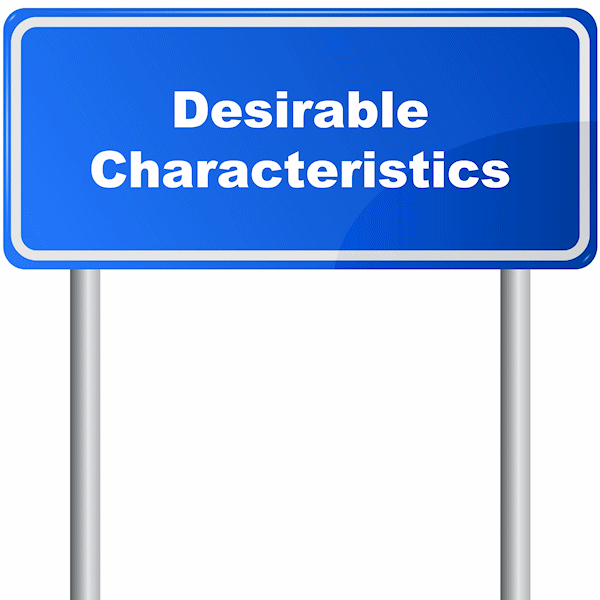By Mike Loughrin, CEO for Transformance Advisors
The Challenge
Selecting an appropriate Six Sigma project can be challenging. You don’t want to find yourself in a multi-year galactic struggle – with no hope of success. Alternatively, you don’t want to waste time by having a project team research and decide on the flavors of ice cream to serve at the company picnic.
Let’s look at a sensible three step approach:
- Identify desirable characteristics which promote success and positive outcomes
- Establish a scoring technique which quantifies each characteristic
- Score possible projects to determine their viability
- High scoring projects become candidates for action
- Low scoring projects are dropped or refined to improve their score
The goal is to establish criteria which identifies the best projects for Six Sigma. Let’s look closer at each step.

1. Desirable Project Characteristics
All possible projects have characteristics which point to their relative value to an organization and to the probabilities of success.
Unfortunately, too many projects get “approved” for all the wrong reasons. I was meeting with the leadership team for one organization and the topic of projects came up. One frustrated person exclaimed his predicament in having about 150 projects assigned to him. His boss was amazed and had no idea this person had been assigned so many projects. The proof came from an excel file listing all the projects. Most had been “assigned” during routine staff meetings without any evaluation of their value. As you may suspect, nothing was happening with most of these projects and nothing ever would.
For many, it’s time to stop the madness and identify the desirable characteristics which will be used to systematically approve new projects. These characteristics can vary by organization, but will often include 3 areas:
- Alignment
- Value
- Resources
Let’s examine each in more detail.

Project Characteristic: An important aspect of the project which helps the team determine if this idea is a great fit for Six Sigma.
Alignment
When it comes to alignment, a scorecard should examine how the project supports organizational strategy and methodologies. This will involve knowing the alignment in terms of:
- Strategic Initiatives
- Scope
- Six Sigma Methodology
Ideally, your leadership team has identified 3 to 5 strategic initiatives which have been designed to achieve your organization’s vision and mission. These strategic initiatives would be the starting point for a vast majority of projects funded by the organization.
Now, if your leadership team has not done the hard work of setting priorities in terms of 3 to 5 strategic initiatives, then you need an alternative approach. You may need to meet with executives (the ones who should have established the initiatives) to discuss organizational goals and priorities.
Do your Six Sigma program a favor and commit to identifying the real strategic priorities. Then use these priorities to evaluate the viability of any project.
Beyond supporting a strategic initiative, a great project will have a reasonable scope. Something which can be accomplished in 3 to 6 months will generally have a higher chance of success. One company analyzed their project failures and discovered a large percentage of failed projects had drifted beyond 6 months. These poorly scoped projects simply ran out of interest and energy.
One last alignment characteristic, for a Six Sigma project, is knowing if the DMAIC methodology is appropriate for the potential project. Six Sigma is about eliminating the defects per opportunity to have a defect. It is a methodology seeking to use powerful statistical analysis on massive amounts of data. Six Sigma is not for every project. You want to avoid that temptation where “if all you have is a hammer, then every problem looks like a nail”.
You will be able to score any possible project, in terms of strategic alignment, by evaluating:
- Does the project support a strategic initiative?
- What is the scope in terms of estimated time to completion?
- Can the DMAIC methodology be used?

Value
Voice of the Customer is a critical aspect of all Six Sigma projects. It should be front and center when evaluating any potential project.
A project scorecard will often seek an understanding of:
- Customer Value
- Stakeholder Value
- Amount of Variation
- Return on Investment
The first situation is bringing value to customers. Will your customers pay more, and/or buy more, after the project is complete? Too many people jump to a conclusion and claim the customer will never pay more for anything. This simplistic thinking ignores how customers are tired of having to inspect every order or carry inventory due to poor service levels. It also ignores the possibility you could grow revenue – once you demonstrate you are serious about meeting customer needs.
Beyond customers, a great project will provide value to other stakeholders. Lower costs in another department when variation is reduced. Improved quality of work life when poor processes are fixed. Improved customer service can deliver increased revenue, leading to increased bonuses and profit sharing for everyone.
A project which does not provide positive financial impact for stakeholders would deserve a low score.
For any Six Sigma project, reducing variation must be the focus.
In terms of return on investment (ROI), you don’t need all the details for a scorecard. You do want a general idea on the benefits from the project vs. the cost of the project. The details will begin to emerge when you create a project charter.
You will be able to score any possible project, in terms of value, by examining:
- Will customers pay more or buy more?
- Do other stakeholders see financial, or quality of work life, benefits?
- Will variation be reduced and defects eliminated?
- What is an estimate for return on investment from the project?

Resources
Having resources, in terms of people, time, and money, is a challenge for many projects.
For the purpose of creating a scorecard, there are three resources to know up front. The time and money challenges can be addressed if the project scores well. The things to know up front involve:
- Project Champion
- Project Manager
- Project Team
When it comes to a project champion, you want to know if an executive is willing and able to own the leadership role and delegate the management role. You can score any project and acknowledge a project champion is not available. However, you should never start a project without this critical resource.
A very similar situation exists when it comes to a project manager. Is someone available? Now, most likely, the future project manager is often the person who completes the scorecard. The project manager role is not a show stopper. You can still complete a scorecard and highlight the need for this resource.
In terms of a project team, you do not need to have one sitting around waiting for a project to drop into their collective laps. For purposes of a scorecard, you want to know if the possible project will need a team to contribute knowledge, work the tasks, and deliver results. If a team is not needed, then you may just have some small solo effort. You do not have a project and don’t need to waste the time of a champion or manager.
You will be able to score any possible project, in terms of resources, by examining:
- Is this important enough for an executive to commit their time to be the project champion?
- Has a potential project manager been identified?
- Will a team be required?

2. Establish Scoring Technique
After identifying characteristics, you need to define how you will measure each one.
The first step is to set the priority for each characteristic. For example, you may choose to identify customer value as high priority and needing a project team as relatively lower priority. The justification is a high scoring project will generate the need for a project team and most organizations don’t have teams just sitting around. Given the 10 characteristics described, and shown on the right, it is reasonable to force rank the list and establish 3 as high, 2 as medium, and 1 as low. While all 10 are important for the success of a project, they are not all equal.
Your second step is to determine the possible answers and the points available for each characteristic. Many of the characteristics are yes or no questions. Several, such as estimated ROI, can be small, medium, or large. None should be more complicated – you want the scoring technique to be fast and uncomplicated. The points awarded, for each answer, could be 5 for yes and 0 for no, or 5 for large, 3 for medium, and 0 for small.
The math for calculating the weighted score, for each characteristic is straight forward. Take the priority (1, 2, or 3) times the points awarded (0, 3, or 5) to get the weighted score for each characteristic.
You should begin to see how a high priority characteristic, like customer value, needs to be yes!

| Project Characteristic | Priority | Possible Answer & Points |
|---|---|---|
| Project Champion | 3 | Yes = 5 No = 0 |
| Project Manager | 3 | Yes = 5 No = 0 |
| Customer Value | 3 | More revenue = 5 Appreciation = 3 Won’t notice = 0 |
| DMAIC Methodology | 2 | Yes = 5 No = 0 |
| Strategic Initiatives | 2 | Yes = 5 No = 0 |
| Return on Investment | 2 | Large = 5 Medium = 3 Small = 0 |
| Scope | 2 | 3 to 6 months = 5 7 to 9 months = 3 Over 9 months = 0 |
| Stakeholder Value | 1 | Financial benefits = 5 Appreciation = 3 Won’t notice = 0 |
| Amount of Variation | 1 | Yes = 5 No = 0 |
| Project Team | 1 | Yes = 5 No = 0 |
“We have too many projects on our list. Many of them would not be there if we did an honest and quantitative scorecard.”
– Frustrated Six Sigma Enthusiast
3. Score Possible Projects
Time to bring it all together. You are now ready to create a scorecard for possible projects.
Given a weighted score for each characteristic, you simply add them up to get the score for a potential project. This should be a quick process.
A sample scorecard for one potential project is below.
| Project Characteristic | Priority | Possible Answer & Points |
Points Awarded |
Weighted Score |
|---|---|---|---|---|
| A project champion is available and wants to support this project. | 3 | Yes = 5 No = 0 |
5 | 15 |
| A project manager is available and can allocate time to work this project to conclusion. |
3 | Yes = 5 No = 0 |
5 | 15 |
| Customers will see value in the results. They will pay more and/or buy more. | 3 | More revenue = 5 Appreciation = 3 Won’t notice = 0 |
5 | 15 |
| The DMAIC methodology is appropriate for this project. | 2 | Yes = 5 No = 0 |
5 | 10 |
| This project is directly tied to one, or more, strategic initiatives. | 2 | Yes = 5 No = 0 |
5 | 10 |
| The estimated return on investment (ROI) for this project is significant. | 2 | Large = 5 Medium = 3 Small = 0 |
5 | 10 |
| The estimated scope for this project is reasonable. | 2 | 3 to 6 months = 5 7 to 9 months = 3 Over 9 months = 0 |
5 | 10 |
| Beyond customers, other stakeholders will see value in the results. | 1 | Financial benefits = 5 Appreciation = 3 Won’t notice = 0 |
5 | 5 |
| The project involves a process with a large amount of data where variation is leading to defects. |
1 | Yes = 5 No = 0 |
5 | 5 |
| We need a project team to identify and implement a solution. | 1 | Yes = 5 No = 0 |
5 | 5 |
| Total score: | – | – | – | 100 |
High Scores (91 or above)
Get this project in front of an approval committee. Time to move.
Low Scores
Don’t abandon potential projects with a low score. Take a closer look at what is driving the low score.
If you did not see increased revenue from customers, then look closer. Improved product availability almost always leads to more revenue. Faster product development will clearly deliver more revenue. Too many Six Sigma enthusiasts are timid when it comes to recognizing customer value. Don’t be timid!
One characteristic, which usually needs greater understanding, is identifying the scope in terms on how long you think it will take to complete a project. Seek to scope projects for 3 to 6 months. Work hard to cut larger projects into smaller ones. There is simply too much risk associated with long projects.
Should you find no opportunity to refine the project, and raise the score, then drop it and move on. Do not waste your time, and risk your career, by forcing a bad idea to the next step.

Summary
Six Sigma is a great approach for many projects. However, DMAIC is not a methodology you should use for every project which comes along.
Certain characteristics make some projects ideal for Six Sigma, while others indicate a different approach would generate better results.
Sorting out which projects, are best for Six Sigma, requires a systematic project selection process. A critical aspect is the use of a project scorecard to evaluate possible projects using quantifiable criteria.
You don’t want to get trapped with a long list of cost cutting projects, when top executives are more interested in seeing dramatic improvement in the quality of products and services. A Six Sigma program can quickly be viewed as just a bunch of cost cutting projects unrelated to organizational strategy. This is not what generates great results for successful organizations.

Complete A Scorecard Now
Mike Loughrin is the CEO and Founder of Transformance Advisors. He also teaches for Louisiana State University Shreveport and is on the board of directors for the Association for Supply Chain Management Northern Colorado.
Mike brings exceptional experience in industry, consulting services, and education. Mike has helped organizations such as Levi Strauss, Warner Home Video, Lexmark, and Sweetheart Cup.
Keeping a commitment to a balanced life, Mike loves downhill skiing, bicycle rides, and hiking in the mountains. See one of his trails of the month at: Little Switzerland.
Six Sigma Belts
Statistics Phobia
Critical to Quality
What is Six Sigma?
Project Champion Guidelines
Subscribe to our newsletter
References
Organizational Improvement Acronyms by Transformance Advisors
Organizational Improvement Definitions by Transformance Advisors

